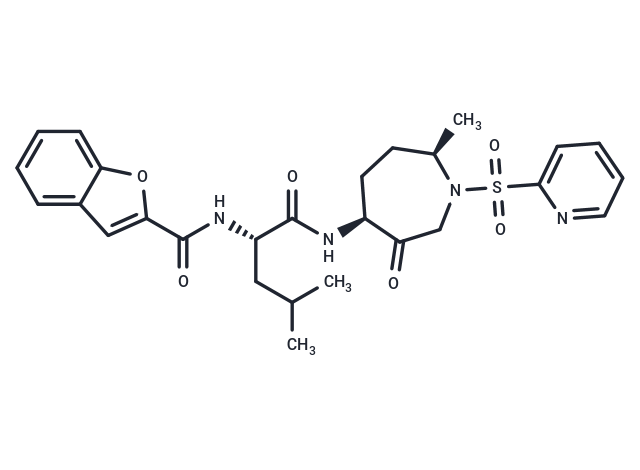Shopping Cart
- Remove All
 Your shopping cart is currently empty
Your shopping cart is currently empty

Relacatib (SB-462795) is a novel, potent, and orally active inhibitor of human cathepsins K, L, and V, exhibiting high affinity with Ki values of 41 pM, 68 pM, and 53 pM, respectively. It effectively inhibits endogenous cathepsin K in situ in human osteoclasts and human osteoclast-mediated bone resorption with IC50 values of 45 nM and 70 nM, respectively. In vitro studies confirm its inhibitory effect on bone resorption in human tissue, and in vivo studies on cynomolgus monkeys validate its efficacy in reducing bone resorption.

| Pack Size | Price | Availability | Quantity |
|---|---|---|---|
| 5 mg | $1,970 | Backorder |
| Description | Relacatib (SB-462795) is a novel, potent, and orally active inhibitor of human cathepsins K, L, and V, exhibiting high affinity with Ki values of 41 pM, 68 pM, and 53 pM, respectively. It effectively inhibits endogenous cathepsin K in situ in human osteoclasts and human osteoclast-mediated bone resorption with IC50 values of 45 nM and 70 nM, respectively. In vitro studies confirm its inhibitory effect on bone resorption in human tissue, and in vivo studies on cynomolgus monkeys validate its efficacy in reducing bone resorption. |
| Targets&IC50 | Cathepsin K:41 pM (Ki), Cathepsin L:68 pM , Cathepsin V:53 pM |
| In vitro | Relacatib, when tested in vitro using human osteoclastoma-derived osteoclasts on bovine cortical bone slices, exhibits significant inhibitory activity. The compound's potency is evidenced by its Ki values: 0.041 nM (human cathepsin K), 0.068 nM (human cathepsin L), 0.063 nM (human cathepsin V), 1.6 nM (human cathepsin S), and 13 nM (human cathepsin B)[1]. Moreover, Relacatib demonstrates specific inhibitory effects against various cathepsins in animal models: in monkeys, Ki values are 0.041 nM (cathepsin K), 0.28 nM (cathepsin L), 0.72 nM (cathepsin V), and 11 nM (cathepsin B); in mice, a Ki value of 0.20 nM (cathepsin L); and in rats, 0.17 nM (cathepsin L)[2], showcasing its broad-spectrum activity across different species. |
| In vivo | Relacatib administered to male Sprague-Dawley rats (1-2 mg/kg via 0.5 h intravenous infusion; 2-4 mg/kg via oral bolus gavage) demonstrates pharmacokinetic parameters including a half-life (T 1/2) of 109 minutes, a clearance rate (CL) of 19.5 mL/min/kg, and a steady-state volume of distribution (Vdss) of 1.86 L/kg. In monkeys, these parameters were observed as 168 minutes, 11.7 mL/min/kg, and 1.79 L/kg, respectively, in pharmacokinetic iv/po crossover studies. The oral bioavailability of Relacatib was found to be 28% in monkeys and 89.4% in rats[1]. SB-462795, administered as a subcutaneous injection at 12 mg/kg with blood samples collected at 1.5, 4, 24, 48, and 72 hours post-administration, significantly inhibits bone resorption, evidenced by reduced serum levels of the N-telopeptides (NTx) and C-telopeptides (CTx) of type I collagen, markers of bone resorption. However, no significant differences in serum osteocalcin levels, a biomarker of osteoblast activity, were observed between SB-462795 and vehicle-treated animals, except for a noteworthy reduction at 48 hours (42% lower than baseline with SB-462795 vs. 18% lower with vehicle treatment)[2]. This study was conducted using a Cynomolgus monkey model at a dosage of 12 mg/kg for subcutaneous injection, indicating effective suppression of bone resorption from 1.5 to 72 hours post-dosing[2]. |
| Alias | SB-462795 |
| Molecular Weight | 540.64 |
| Formula | C27H32N4O6S |
| Cas No. | 362505-84-8 |
| Storage | Powder: -20°C for 3 years | In solvent: -80°C for 1 year | Shipping with blue ice. |

Copyright © 2015-2025 TargetMol Chemicals Inc. All Rights Reserved.